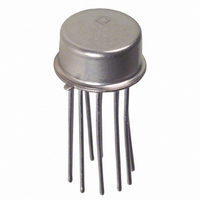AD597AHZ Analog Devices Inc, AD597AHZ Datasheet - Page 5

AD597AHZ
Manufacturer Part Number
AD597AHZ
Description
IC,TEMPERATURE SENSOR,BIPOLAR,CAN,10PIN,METAL
Manufacturer
Analog Devices Inc
Specifications of AD597AHZ
Rohs Compliant
YES
Function
Thermocouple Conditioner
Topology
Ice Point Compensation
Sensor Type
External
Sensing Temperature
-200°C ~ 1250°C
Output Type
Voltage
Output Alarm
Yes
Output Fan
No
Voltage - Supply
5 V ~ 30 V
Operating Temperature
-55°C ~ 125°C
Mounting Type
Through Hole
Package / Case
TO-100, Metal Can (10 Leads)
Bandwidth
15kHz
Supply Voltage Min
5V
Supply Voltage Max
30V
Digital Ic Case Style
SOIC
No. Of Pins
10
Operating Temperature Range
-55°C To +125°C
Svhc
No SVHC (15-Dec-2010)
Accuracy
4°C
Base Number
597
Lead Free Status / RoHS Status
Lead free / RoHS Compliant
Lead Free Status / RoHS Status
Lead free / RoHS Compliant
SETPOINT CONTROL MODE
The AD596/AD597 can be connected as a setpoint controller as
shown in Figure 2. The thermocouple voltage is cold junction
compensated, amplified, and compared to an external setpoint
voltage. The relationship between setpoint voltage and tempera-
ture is given in Table I. If the temperature to be controlled is
within the operating range (–55 C to +125 C) of the device, it
can monitor its own temperature by shorting the inputs to
ground. The setpoint voltage with the thermocouple inputs
grounded is given by the expressions:
The input impedance of the setpoint pin of the AD596/AD597
is approximately 50 k . The temperature coefficient of this
resistance is 15 ppm/ C. Therefore, the 100 ppm/ C 5 k pot
shown in Figure 2 will only introduce an additional 1 C degra-
dation of temperature stability over the +25 C to +100 C ambi-
ent temperature range.
Switching hysteresis is often used in setpoint systems of this type
to provide noise immunity and increase system reliability. By
reducing the frequency of on-off cycling, mechanical component
wear is reduced leading to enhanced system reliability. This can
easily be implemented with a single external resistor between
Pins 7 and 3 of the AD596/AD597. Each 200 nA of current
injected into Pin 3 when the output switches will cause about
1 C of hysteresis; that is:
In the setpoint configuration, the AD596/AD597 output is
saturated at all times, so the alarm transistor will be ON regard-
less of whether there is an open circuit or not. However, –ALM
must be tied to a voltage below (+V
of the rest of the circuit.
STAND-ALONE TEMPERATURE TRANSDUCER
The AD596/AD597 may be configured as a stand-alone Celsius
thermometer as shown in Figure 3.
REV. B
TEMPERATURE
CONTROLLED
REGION
AD596 Setpoint Voltage = C
AD597 Setpoint Voltage = C
Figure 2. Setpoint Control Mode
CONSTANTAN
(ALUMEL)
IRON
(CHROMEL)
R
HYST
( )
HYSTERESIS
(OPTIONAL)
200 nA
V
R
OUT
AD596/
AD597*
S
– 4 V) for proper operation
9.6 mV/ C + 42 mV
10.1 mV/ C – 9.1 mV
HEATER
DRIVER
*H PACKAGE PINOUT SHOWN
SET-
POINT
VOLTAGE
C
HYST
1
0.01 F
VOLTAGE
TEMPERATURE
COMPARATOR
POINT
SET-
100ppm/ C
OUTPUT
+V
5k
V
REF
–5–
Simply omit the thermocouple and connect the inputs (Pins 1
and 2) to common. The output will now reflect the compensa-
tion voltage and hence will indicate the AD596/AD597 tem-
perature. In this three terminal, voltage output, temperature
sensing mode, the AD596/AD597 will operate over the full
extended –55 C to +125 C temperature range. The output
scaling will be 9.6 mV per C with the AD596 and 10.1 mV per
with the AD596 causing it to read slightly high when used in
this mode.
THERMOCOUPLE CONNECTIONS
The connection of the thermocouple wire and the normal wire
or printed circuit board traces going to the AD596/AD597
forms an effective reference junction as shown in Figure 4. This
junction must be kept at the same temperature as the AD596/
AD597 for the internal cold junction compensation to work
properly. Unless the AD596/AD597 is in a thermally stable
enclosure, the thermocouple leads should be brought in directly
to Pins 1 and 2.
To ensure secure bonding, the thermocouple wire should be
cleaned to remove oxidization prior to soldering. Noncorrosive
resin flux is effective with iron, constantan, chromel, and
alumel, and the following solders: 95% tin–5% silver, or 90%
tin–10% lead.
NOTE:
A BIAS RETURN PATH
FROM PINS 1 AND 2
OF LESS THAN 1k
IMPEDANCE MUST BE
PROVIDED.
C with the AD597. Additionally there will be a 42 mV offset
CONSTANTAN
Figure 3. Stand-Alone Temperature Transducer
Temperature Proportional Output Connection
(CHROMEL)
(ALUMEL)
IRON
REFERENCE JUNCTION
POINT
COMP
ICE
Figure 4. PCB Connections
GND
+
–
G
+
–
–V
0.01 F
G
S
AD597*
AD596/
–V
+
0.01 F
S
AD596/
AD597*
+
*H PACKAGE PINOUT SHOWN
A
AD596/AD597
*H PACKAGE PINOUT SHOWN
+V
S
0.01 F
0.01 F
V
9.6mV/ C
LIMITING RESISTOR
OUT
+V
V
TO
LED
OUT
S









